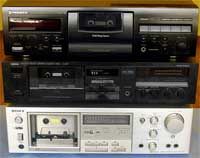Difference Between Mono and Stereo

Mono and Stereo are two classifications of reproduced sound. Mono is the term used to describe sound that is only from one channel while stereo uses 2 or more channels to provide an experience much like being in the same room where the sound was created. Listening to a stereo sound allows you to distinguish which sound is coming from which direction which is very similar to being in the same room as the sound was created. This provides listeners with a much more natural experience compared to where the sound comes from a single direction.
The most prominent use of stereo sound is in music where multiple sources of sound are present. When you are listening to a band play and you have a sharp ear, you can distinguish the sound made by each instrument. This is what stereo tries to replicate with the use of multiple channels and what mono is completely unable to do. This is why all radio stations that broadcasts music use stereo, using mono would simply result in inferior sound.
Mono is still widely used today in situations where stereo only takes up bandwidth and offers no advantages. A good example for this is in voice communications like in talk radio and telephone calls. In these cases, the only desired source of sound is the mouth of the speaker, utilizing two channels for this would only mean a greater bandwidth taken up which is counterproductive.
The equipment needed to record stereo sound is also a little bit more complicated and pricey compared to equipment for mono. Recording mono sound requires only a single microphone and the data it acquires is automatically stored in magnetic tape or converted to digital formats for storage. With stereo, you would need multiple microphones along with the equipment needed to splice the multiple channels together in order to create a single sound stream that a player can break apart into the original channels. This is why most hand-held sound recorders can only record sound in mono since stereo recording is not really needed for the applications they are used for.
Summary:
1. Mono sound uses only a single channel while stereo sound uses two channels or more
2. Stereo sound gives you a more natural listening experience compared to mono
3. Stereo is essential for broadcasting and listening to music since Mono provides inadequate sound quality
4. Mono is used widely in talk radio and mobile communications since stereo doesn’t really provide any practical advantages in these situations
5. Recording in mono is less complicated compared to recording in stereo
6. Most hand-held voice recorders can only record in mono
- Difference Between Sony Cybershot S Series and W Series - December 22, 2012
- Difference Between Samsung Galaxy S3 and iPhone 5 - December 21, 2012
- Difference Between Samsung Galaxy S2 (Galaxy S II) and Galaxy S 4G - December 20, 2012

Well described… Thx .. for so detailed explanation..
Thanks a lot..
good definition,
I have one doubt,
In Stereo, defiantly 2 speakers are required or same effect can achieve in single speaker?
thanks i need to write in exam
when i play the music system with only left or right speaker but not both…is the sound produced is mono or stereo?
it is on the track whether it is stereo or mono…not on the speakers…
speakers will fire as per the tracks…single speaker will give u mono/stereo but as i told u depends on the track ur playing.
track means recording of music.
sound/song/movie etc
“Stereo is essential for broadcasting and listening to music since Mono provides inadequate sound quality”
This couldn’t be more wrong. Mono can actually sound better than stereo when it comes listening to music
Thank you so much for your explanation, especially in summary.